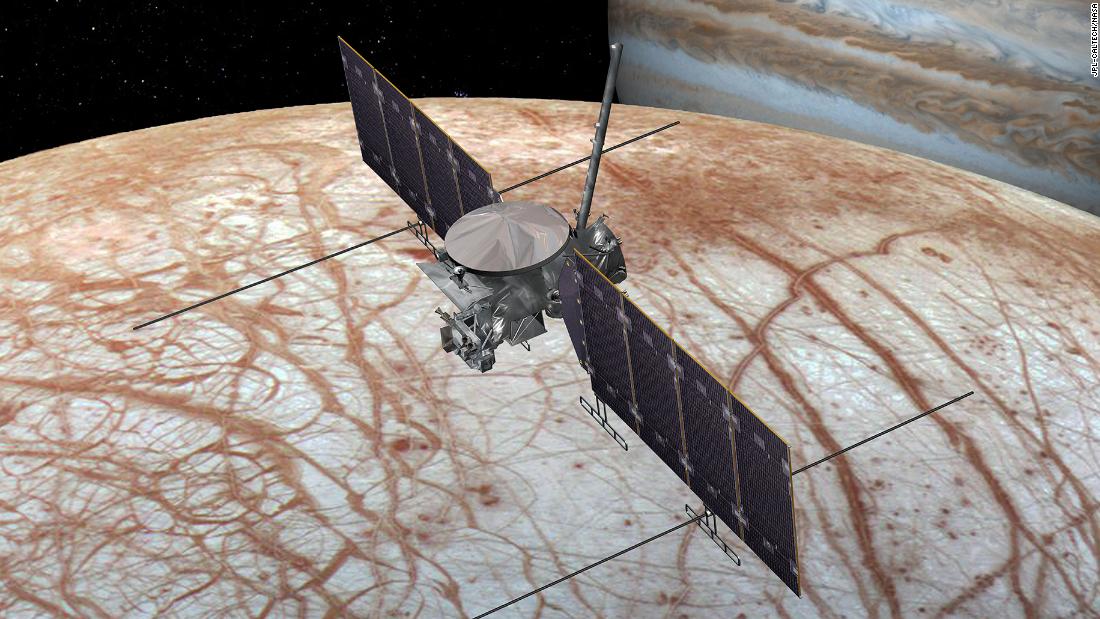[ad_1]
The research team observed Europa using the W. M. Keck Observatory in Hawaii — one of the biggest telescopes in the world — for 17 nights between 2016 and 2017. On one of those nights, they detected the signal for water vapor.
The researchers observed 5,202 pounds of water releasing from Europa per second, which could fill an Olympic-size swimming pool within minutes, according to NASA.
“Essential chemical elements and sources of energy, two of [the] three requirements for life, are found all over the solar system. But the third — liquid water — is somewhat hard to find beyond Earth,” said Lucas Paganini, study author and NASA planetary scientist. “While scientists have not yet detected liquid water directly, we’ve found the next best thing: water in vapor form.”
But this amount is infrequent — at least when scientists are trying to observe it from Earth.
“For me, the interesting thing about this work is not only the first direct detection of water above Europa, but also the lack thereof within the limits of our detection method,” Paganini said.
How Europa could host life
Research suggesting the possibility of an ocean on Europa was published as early as 1977, after the Voyager mission observed long lines and dark spots instead of a cratered surface similar to other moons. Then the Galileo spacecraft reached Europa in 1996 and revealed for the first time that there was an ocean on another planet.
Last year, Kivelson and her colleagues took a closer look at that data. They realized that during the flyby, Galileo flew through a plume — a burst of liquid from Europa’s ocean that pierces through the moon’s icy shell. This fortuitous happenstance is the best evidence of plumes to date, the study said.
While Galileo didn’t know it was flying through a plume and was incapable of collecting material from it, an upcoming mission with the Europa Clipper will be able to gather samples from plumes if it can fly through them. This would allow scientists a first look at the material inside Europa’s ocean that’s spewing through the icy crust, and that could reveal whether Europa’s ocean is habitable.
As Paganini noted, the necessary ingredients for life as we know it include liquid water, energy sources and chemicals such as carbon, hydrogen, oxygen, nitrogen, sulfur and phosphorus. Europa and Saturn’s moon Enceladus show some of these key ingredients for life in their oceans, which is why researchers believe they are the best chance for finding life beyond Earth in our own solar system.
Europa Clipper’s instruments will be capable of “sniffing” the atmosphere of the moon, with more than 40 planned flybys. The flybys will be less than 228 miles above the surface of Europa and within the observed range of the plumes, which can reach 124 to 228 miles above the surface.
“If plumes exist and we can directly sample what’s coming from the interior of Europa, then we can more easily get at whether Europa has the ingredients for life,” said Robert Pappalardo, Europa Clipper project scientist. “That’s what the mission is after. That’s the big picture.”
The Europa Clipper, named for the streamlined sailing ships of the 1800s, could launch as early as 2023, but a targeted launch has been set for 2025. It is expected to reach Europa after a journey lasting several years.
Europa Clipper will carry cameras and spectrometers to capture images and determine the composition of the moon. Ice-penetrating radar will measure the thickness of the ice shell covering the ocean, and help search for the subsurface lakes believed to be there — much like those in Antarctica on Earth. A magnetometer can determine the strength and direction of the moon’s magnetic field to understand how deep the ocean goes and its salinity.
[ad_2]
Source link




